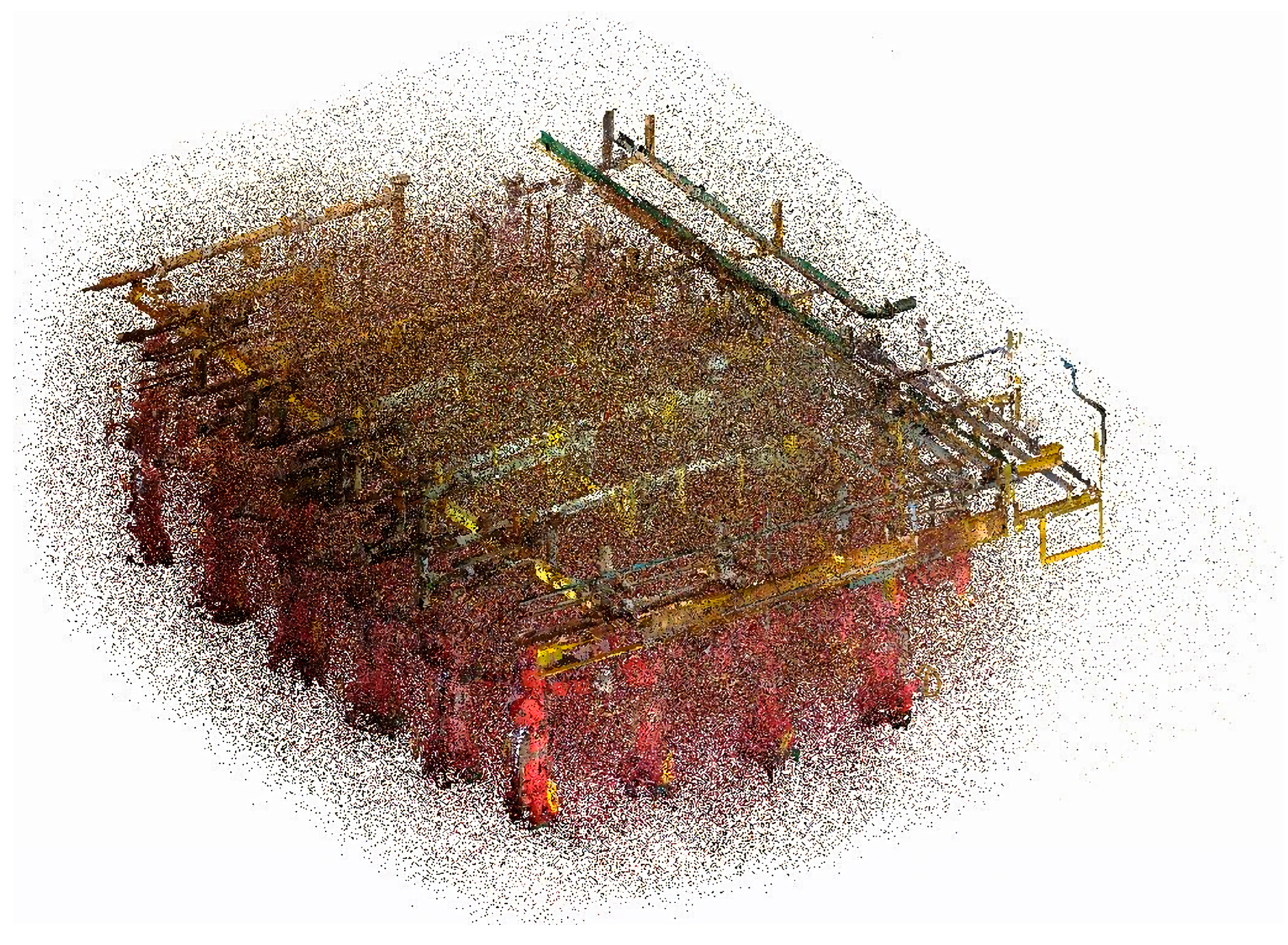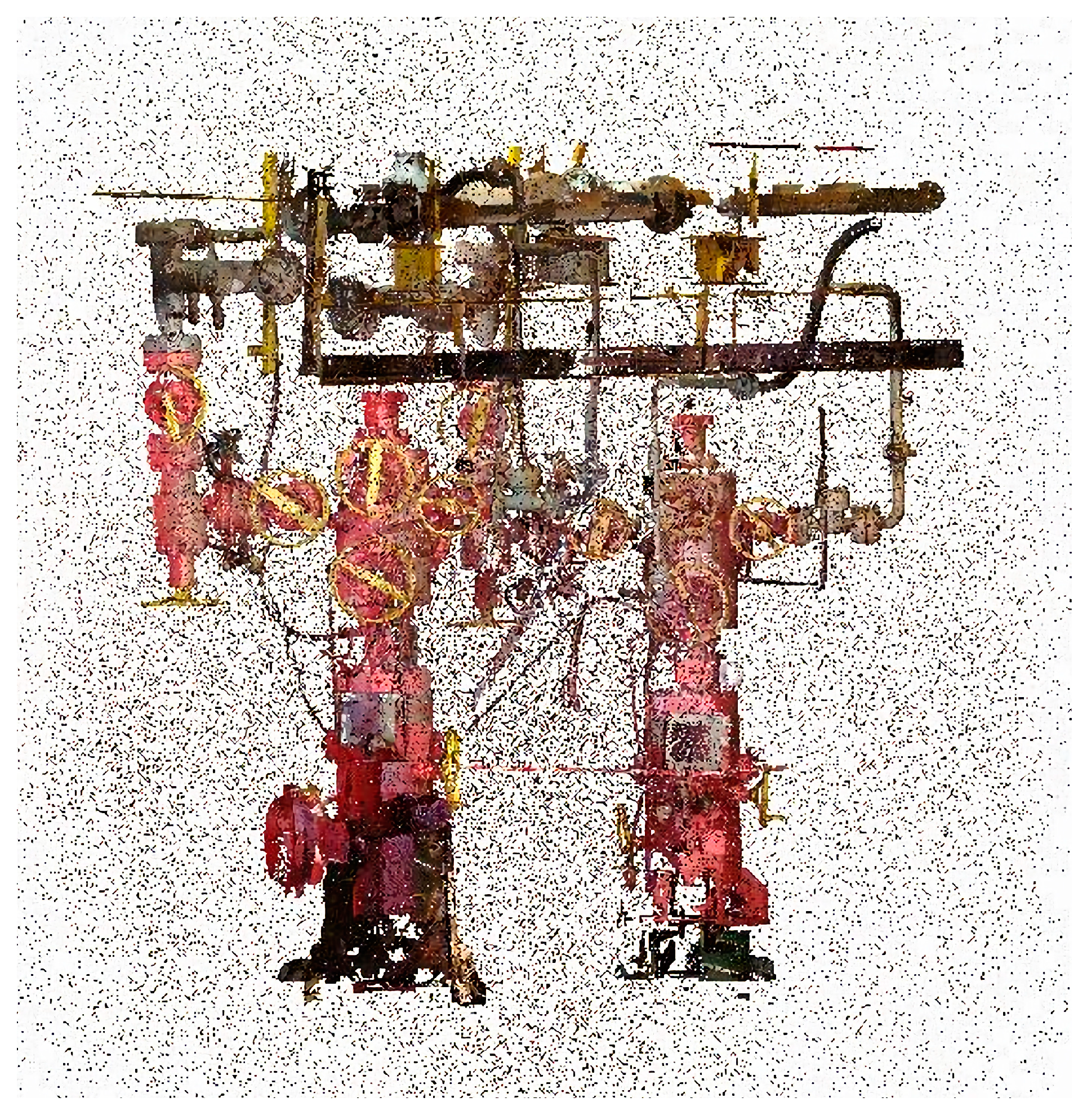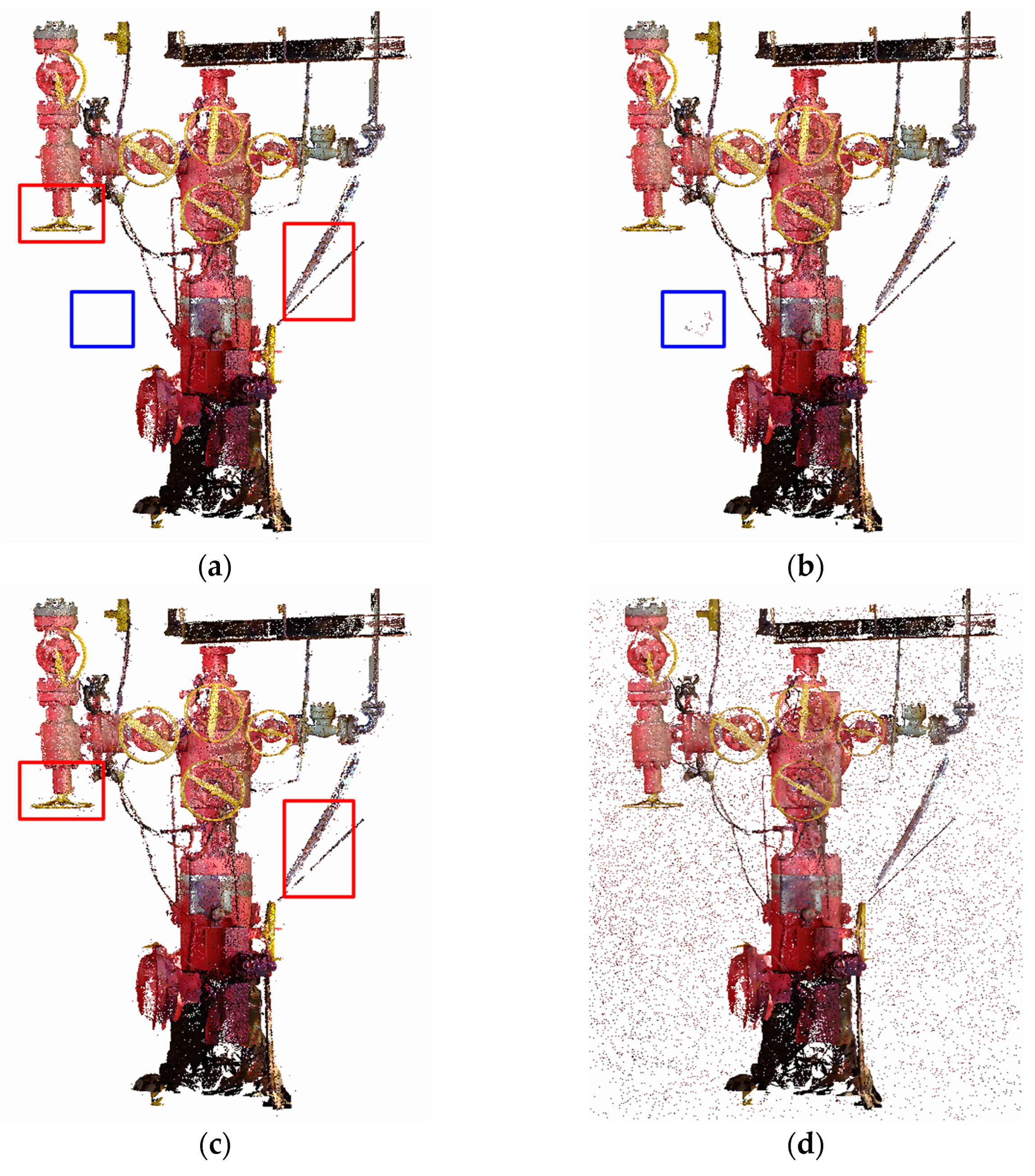The experimental method of this study is systematically structured into three main parts to evaluate and compare the effectiveness of various filtering algorithms in processing point cloud data for offshore oil and gas platforms.
In the first part, two conventional filtering algorithms, the statistical filtering algorithm and the radius filtering algorithm, were applied to a section of the point cloud data from the same offshore oil and gas platform. In addition, this study introduced two novel algorithms: the KNN_PCF (K-Nearest-Neighborhood point cloud filtering) algorithm and the Hy_WHF (hyperbolic weighted hybrid filtering) algorithm. To optimize their performance, we employed a controlled variable method for parameter tuning. Each algorithm’s parameters were systematically adjusted, and multiple comparative experiments were conducted. The primary objective of this phase was to identify the most effective parameter settings for each algorithm, especially to assess the KNN_PCF algorithm’s suitability for this specific dataset.
In the second part, building on the findings from the previous experiments, we established the optimal parameter settings for each algorithm when applied to offshore oil and gas platform data. This phase involved experimenting with both individual and combined applications of the KNN_PCF and Hy_WHF algorithms as well as exploring the synergy between the radius and statistical filtering algorithms. The focus was to validate the efficiency of the combined filtering approach, particularly comparing the noise reduction capabilities of the KNN_PCF and Hy_WHF method against the radius–statistical filtering method.
Finally, the third part of the study utilized the Poisson algorithm to perform 3D reconstruction of the offshore oil and gas platform datasets, pre- and post-denoising. The reconstructions were meticulously compared to evaluate the impact of the various filtering algorithms on the final 3D model quality. This comparative analysis aimed to provide insights into the efficacy of the filtering techniques in enhancing the accuracy and detail of the 3D models of offshore platforms.
3.3.1. Individual Filtering Algorithms
To precisely determine the optimal parameter settings for the offshore oil and gas platform point cloud dataset under different algorithms, this study conducted detailed comparative experiments on statistical filtering, radius filtering, the KNN_PCF algorithm, and the Hy_WHF algorithm, using the part of the offshore oil and gas platform point cloud data shown in
Figure 2. The experiments with these four algorithms were compared horizontally, verifying the efficiency of the KNN_PCF algorithm in removing noise from the point cloud data of offshore oil and gas platforms.
(1) Statistical Filtering
Initially, the standard deviation multiple
σ is fixed at 1.5, and the range for the number of neighborhood search points
Ks is set between 6 and 10, with a step size of 2. This allows for a quantitative estimation of the denoising effect under these parameter settings. Through this process, the optimal value for
Ks can be determined. Subsequently, to further optimize the parameter settings, the range for
σ is set between 1.0 and 2.0—with a step size of 0.5—to ultimately ascertain the best value for
σ. Using this method, we can employ various parameter combinations to achieve the best performance of statistical filtering on the offshore oil and gas platform point cloud data. For each parameter combination of statistical filtering, its precision evaluation parameter values are calculated (
Table 2) (Note: In all tables, bolded rows represent the best algorithm parameters and their corresponding evaluation values, following the same convention).
The table shows the evaluated parameter values of statistical filtering algorithms with different parameter combinations under the point cloud data of offshore oil and gas platforms, and it can be seen from
Table 2 that the denoising of point cloud data is best when the number of neighborhood search points
Ks is 8 and the standard deviation multiplier
σ is 1.5.
(2) Radius Filtering
In the analysis of radius filtering, we first fixed the radius
r to be 0.08 and set the range of the threshold of the number of neighboring points
Kr to be between 60 and 120 with a step size of 30 as a way to quantitatively estimate the denoising effect under different parameters and to determine the optimal value of
Kr. Subsequently, in order to further optimize the parameters, we adjusted the value of
r to a range of 0.06 to 0.10 with a step size of 0.02 so as to finally determine the optimal value of
r. In this way, we are able to use individual parameter combinations to obtain the best performance of radius filtering on offshore oil and gas platform point cloud data. For each parameter combination result of the radius filtering, its accuracy evaluation parameter value was calculated (
Table 3).
The table shows in detail the values of various performance parameters of the radius filtering algorithm under different parameter combinations. As can be seen from
Table 3, when
Kr is 90 and
r is 0.08, the denoising of point cloud data is the best, its target point retention rate is 99.069%, the noise point filtering rate is 82.357%, the denoising rate is 86.082%, and the total error rate is 0.892%.
(3) K-Nearest-Neighborhood Point Cloud Filtering (KNN_PCF)
During the experiment of denoising offshore oil and gas platform point cloud data with the KNN_PCF algorithm, the percentage (
per) was initially set at 4.5, and the range for the number of nearest neighbors (
Kn) was set between 70 and 90, with a step size of 10. Through these settings, we could quantitatively estimate the denoising effects under different parameters and thus determine the optimal value for
Kn. Subsequently, we adjusted the range of
per to be between 4.0 and 5.0, with a step size of 1.0, to find the most suitable value for
per. Using this method, we could employ various parameter combinations to achieve the best performance of the KNN_PCF algorithm on the offshore oil and gas platform point cloud data. For each combination of parameters, we calculated its precision evaluation parameter values (
Table 4).
The table shows the evaluation parameter values of the KNN_PCF algorithm with different parameter combinations for point cloud data of offshore oil and gas platforms. From
Table 4, it can be seen that when the number of nearest neighbors (
Kn) is 80 and the fixed percentage (
per) is set at 4.5, the denoising effect on the point cloud data is the best.
(4) Hyperbolic Weighted Hybrid Filtering (Hy_WHF)
During the Hy_WHF (hyperbolic weighted hybrid filtering) algorithm experiment, we initially fixed the parameter
φ at 0.1 and set the range for the number of nearest neighbors (
Kh) between 15 and 25, with a step size of 5. This was done to quantitatively estimate the denoising effects under different parameters and to determine the best value for
Kh. Then, we adjusted the range of
φ to be between 0.08 and 0.12, with a step size of 0.02, to ultimately find the most suitable value for
φ. Through this process, we could use various parameter combinations to achieve the best performance of the Hy_WHF algorithm on the point cloud data of offshore oil and gas platforms. For each combination of parameters, we calculated its precision evaluation parameter values (
Table 5).
The table provides detailed performance parameter values for the Hy_WHF algorithm under different parameter settings. From
Table 5, it is evident that when the number of nearest neighbors (
Kh) is 20 and the parameter
φ is set at 0.1, the denoising effect on the offshore oil and gas platform point cloud data is the best.
- 2.
Comparison of Different Algorithms
To more thoroughly validate the effectiveness of the KNN_PCF algorithm in removing noise from point cloud data of offshore oil and gas platforms, this study employed a precise experimental method. We used the optimal parameters for each algorithm as determined by meticulous experiments earlier in the paper as a benchmark. Specifically, we selected statistical filtering with parameters
Ks = 8,
σ = 1.5; radius filtering with parameters
Kr = 90,
r = 0.08; KNN_PCF algorithm with parameters
Kn = 80,
per = 4.5; and Hy_WHF algorithm with parameters
Kh = 20,
φ = 0.1. We conducted a detailed comparison of their filtering effects using various indicators and visual analysis. A table of filtering evaluation parameters based on different algorithms was also provided (
Table 6). To visually demonstrate the denoising effects of different filtering algorithms on point cloud data, the denoising results were visualized (
Figure 6).
From the evaluation parameter
Table 6 in the comparative experiments, it is apparent that the KNN_PCF algorithm excels in terms of target point retention rate (TR), noise point screening rate (NSR), and denoising rate (R
d), achieving 99.485%, 89.987%, and 91.417%, respectively. It has the smallest total error of only 0.492. Moreover, the noise point screening rate obtained using the KNN_PCF algorithm is about 7 percentage points higher than that of the radius filtering algorithm, with a total error result that is 0.4 percentage points lower. However, when using the Hy_WHF algorithm alone, its denoising effect is comparatively poorer.
Figure 6 illustrates the selection of regions using blue boxes to highlight the presence of noise points that are not effectively eliminated through statistical filtering but can be successfully removed using the KNN_PCF algorithm. Moreover, red boxes are employed to identify areas where noise persists despite the application of radius filtering but can be effectively addressed by utilizing the KNN_PCF algorithm. By comparing the visualization results of different filtering algorithms in
Figure 6, we can see that statistical filtering effectively removes most noise points, but its handling of dense clustered noise and surface noise is less satisfactory. Radius filtering improves the processing of densely clustered noise points, but also lacks in preserving surface detail of the data. The KNN_PCF algorithm combines the advantages of radius filtering and statistical filtering, effectively removing both dense clustered noise and surface noise.
3.3.2. Combined Filtering Algorithms
Based on the outcomes of previous experiments, it was observed that the KNN_PCF algorithm demonstrated superior performance in comparison to radius and statistical filtering methods in processing point cloud data from offshore oil and gas platforms. However, while the Hy_WHF algorithm individually showed less favorable results than the other algorithms, its combination with the KNN_PCF algorithm was explored to potentially enhance overall filtering effectiveness. Additionally, experiments were conducted to combine radius and statistical filtering methods, aiming to investigate their synergistic effects in different scenarios. This approach also served to provide a comparative benchmark for the combined use of the KNN_PCF and Hy_WHF algorithms.
In this experiment, we used the optimal parameters of each algorithm, as determined through meticulous previous experiments, as a benchmark. We further validated the combined filtering method based on KNN_PCF and Hy_WHF (selecting parameters Kn = 80, per = 4.5, and Kh = 20, φ = 0.1) for its effectiveness in filtering point cloud data of offshore oil and gas platforms. Additionally, we compared this method to the combined filtering method based on radius and statistics (selecting parameters Ks = 8, σ = 1.5, and Kr = 90, r = 0.08) in terms of denoising effects.
To clearly demonstrate the differences between different combined filtering algorithms, we conducted a detailed comparison of their filtering effects using various indicators and visual analysis. A table of filtering evaluation parameters based on different combined algorithms (
Table 7) was listed. The denoising effects of different filtering algorithms on point cloud data were visually demonstrated, with areas of noise points not removed after filtering highlighted in red rectangular frames (
Figure 7). Additionally, a visualization of the offshore oil and gas platform point cloud data after combined filtering based on the KNN_PCF and Hy_WHF algorithms was shown (
Figure 8).
From
Table 7, it is evident that the combined filtering of point cloud data based on the KNN_PCF and Hy_WHF algorithms performs better than the combined filtering algorithm based on statistics and radius in three evaluation parameters: target point retention rate (TR), noise point screening rate (NSR), and denoising rate (R
d). Specifically, in terms of noise point screening rate (NSR), the combined filtering effect of the KNN_PCF and Hy_WHF algorithms is significantly superior to the method based on statistics and radius, with the former being about 11% higher. In terms of the error rate (E
t) evaluation parameter, the performance of the combined filtering based on KNN_PCF and Hy_WHF algorithms (0.206%) far exceeds that of the combined method based on statistics and radius (0.781%).
The regions selected using the red boxes indicate noise points that cannot be rejected by the combined radius- and statistical-filtering-based algorithm but can be rejected by the combined KNN_PCF- and Hy_WHF-based algorithm, and the smoothing effect of the combined KNN_PCF- and Hy_WHF-based algorithm is clearly visible in these regions. The visualization results in
Figure 7 clearly demonstrate the superiority of the combined filtering algorithm based on KNN_PCF and Hy_WHF over traditional combined methods. The significant reduction of noise points in the areas highlighted by red rectangular frames and the better preservation of details are evident.
Figure 8 shows the denoising effect of the combined filtering algorithm based on KNN_PCF and Hy_WHF on the entire offshore oil and gas platform dataset. We can see that the combined algorithm of this study can almost remove all dense clustered noise, surface noise points, and discrete points as well as eliminate light reflection noise, resulting in more accurate color information in the point cloud data.















